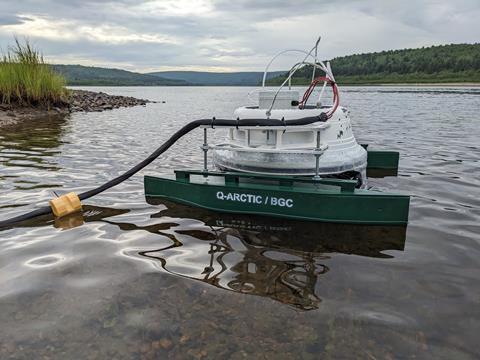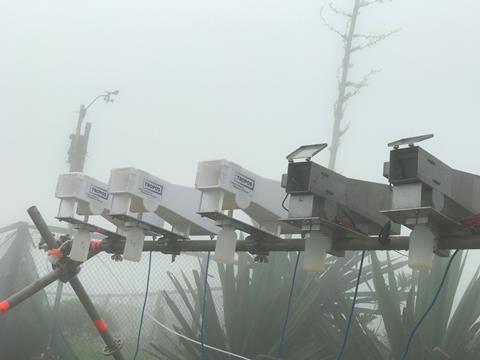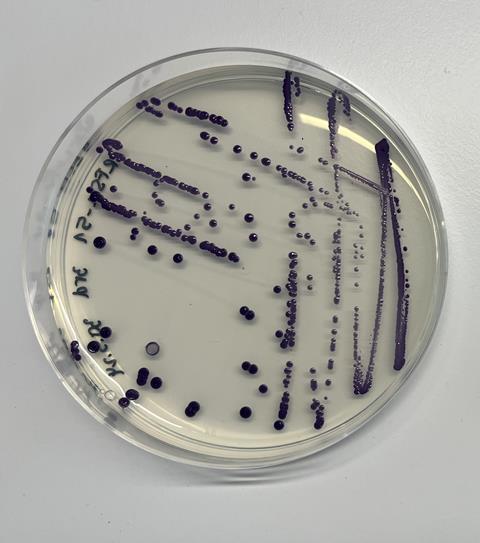The Aero-Aquatic Virus Research Group at the Friedrich-Schiller University Jena led by Dr. Janina Rahlff conducts basic research on microbial viruses from the surface microlayer, the 1-mm thick ‘skin’ of a water body’s surface, and in atmospheric ecosystems.
The surface microlayer (SML) is located at the boundary between atmosphere and hydrosphere. Its position spanning ~70% of the ocean’s surface make it a crucial component for the regulation of gas exchange across the air-sea boundary.
The SML accumulates organic matter, pollutants, microbial cells, and viruses. Organisms thriving in this habitat are referred to as neuston.

My group has a focus on studying the virioneuston and their prokaryotic hosts that enrich in the SML. At times of low wind speeds, the SML becomes visible to the naked eye in short-lived surface features termed slicks, representing zones characterized by the accumulation of surface-active substances that attenuate waves (below).
Glass plate sampler
We sample the SML manually with a glass plate sampler that we submerge into the target area. From the SML, due to its proximity to the atmosphere, biological material including viruses becomes more easily aerosolized.

Our group studies diversity, virus-host interactions, adaptations, and dispersal from the SML within and outside of slicks, and associated features such as sea foam. We combine field work with cultivation approaches, physiological measurement (O2 consumption rates), and metagenomic predictions.
We recently worked on viral data from Synoptic Arctic Survey 2021 and plan to sample SML from thermokarst lakes in the Canadian Arctic to explore the role of interfacial microbes in gas exchange measured by a floating chamber (below), and the role of viruses in influencing microbial communities that regulate gas exchange in these climate-affected areas.

Viruses from the sky
Viruses are understudied components of the atmosphere. While the COVID-19 pandemic has contributed to a better understanding of viral dispersal with aerosols indoors, we know very little about the viral communities in outside air, which is another research focus of my working group.
We monitor virus-like particles in rainwater at a marine versus non-marine station to correlate numbers with precipitation volume, ice-nucleating potential, and bacterial and viral community structure. This is to identify seasonal fluctuations and influences exerted by the sampling site and different sources of air masses.
Sequences from cloudwater
We work with viral sequences recovered from cloudwater sampled by collaborators at the Monte Verde, Cabo Verde (below), the Puy de Dôme in France, and from Antarctic aerosols.

Our aim is to better understand viral adaptions to this extreme environment, to their hosts (do they find any? Do they replicate within tiny air droplets?), transmission sources and routes and the potential of a virus to remain infectious to prokaryotes in the dispersal destination.
In addition, we isolate bacteria and their viruses (phages) from rainwater, cloudwater, and aerosols. Our bacterial isolates show that pigmentation and spore-formation are typical responses to the atmospheric life exposed to solar radiation, temperature fluctuations, and desiccation (below).


We are also interested in understanding the adaptations of viruses to the atmospheric environment, particularly at the genomic level as we could previously observe that air viruses have a significantly higher proportion of guanine and cytosine in their DNA compared to marine viruses. One major challenge for high-throughput sequencing is the generally low biomass found in air, which is why we complement sequencing efforts with cultivation approaches.
Dr Janina Rahlff sits on AMI’s Ocean Sustainability Research Advisory Group
Affiliations:
-Aero-Aquatic Virus Research Group, Faculty of Mathematics and Computer Science, Friedrich Schiller University Jena, Jena, Germany
-Leibniz Institute on Aging - Fritz Lipmann Institute (FLI), Jena, Germany
-Centre for Ecology and Evolution in Microbial Model Systems (EEMiS), Department of Biology and Environmental Science, Linnaeus University, Kalmar, Sweden







No comments yet